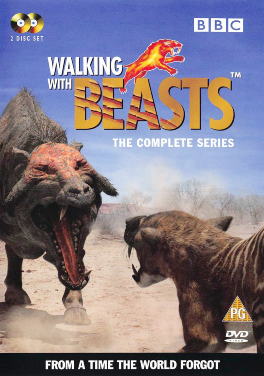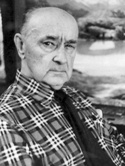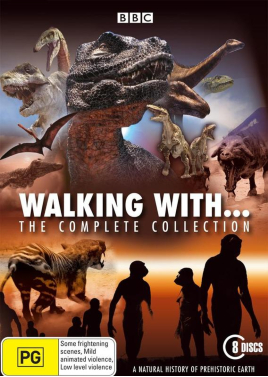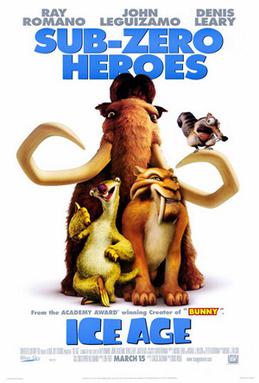
Walking with Cavemen is a 2003 four-part nature documentary television miniseries produced by the BBC Science Unit, the Discovery Channel and ProSieben. Walking with Cavemen explores human evolution, showcasing various extinct hominin species and their inferred behaviours and social dynamics. The original British version of the series is presented by the British researcher Robert Winston; in the American version Winston's appearances and narration is replaced with narration by Alec Baldwin.

Walking with Dinosaurs is a 1999 six-part nature documentary television miniseries created by Tim Haines and produced by the BBC Science Unit, the Discovery Channel and BBC Worldwide, in association with TV Asahi, ProSieben and France 3. Envisioned as the first "Natural History of Dinosaurs", Walking with Dinosaurs depicts dinosaurs and other Mesozoic animals as living animals in the style of a traditional nature documentary. The series first aired on the BBC in the United Kingdom in 1999 with narration by Kenneth Branagh. The series was subsequently aired in North America on the Discovery Channel in 2000, with Avery Brooks replacing Branagh.

Walking with Beasts, marketed as Walking with Prehistoric Beasts in North America, is a 2001 six-part nature documentary television miniseries created by Impossible Pictures and produced by the BBC Science Unit, the Discovery Channel, ProSieben and TV Asahi. The sequel to the 1999 miniseries Walking with Dinosaurs, Walking with Beasts explores the life in the Cenozoic era, after the extinction of the non-avian dinosaurs, particularly focusing on the rise of the mammals to dominance. The UK version of the series is narrated by Kenneth Branagh, who also narrated Walking with Dinosaurs, and the US version is narrated by Stockard Channing.

Zdeněk Michael František Burian was a Czech painter, book illustrator and palaeoartist. Burian's artwork played a central role in the development of palaeontological reconstruction and he is regarded as one of the most influential palaeoartists of all time.

Sea Monsters, marketed as Chased by Sea Monsters in the United States, is a 2003 three-part nature documentary television miniseries created by Impossible Pictures and produced by the BBC Studios Science Unit, the Discovery Channel and ProSieben. Following in the footsteps of The Giant Claw (2002) and Land of Giants (2003), special episodes of the nature documentary series Walking with Dinosaurs, Sea Monsters stars British wildlife presenter Nigel Marven as a "time-travelling zoologist" who travels to seven different periods of time in prehistory, diving in the "seven deadliest seas of all time" and encountering and interacting with the prehistoric creatures who inhabit them. The series is narrated by Karen Hayley.

Walking with Monsters – Life Before Dinosaurs, marketed as Before the Dinosaurs – Walking with Monsters in North America, is a 2005 three-part nature documentary television miniseries created by Impossible Pictures and produced by the BBC Studios Science Unit, the Discovery Channel, ProSieben and France 3. Walking with Monsters explores life in the Paleozoic era, showcasing the early development of groups such as arthropods, fish, amphibians, reptiles and synapsids. Like its predecessors Walking with Dinosaurs (1999) and Walking with Beasts (2001), Walking with Monsters is narrated by Kenneth Branagh.

A nature documentary or wildlife documentary is a genre of documentary film or series about animals, plants, or other non-human living creatures. Nature documentaries usually concentrate on video taken in the subject's natural habitat, but often including footage of trained and captive animals, too. Sometimes they are about wildlife or ecosystems in relationship to human beings. Such programmes are most frequently made for television, particularly for public broadcasting channels, but some are also made for the cinema. The proliferation of this genre occurred almost simultaneously alongside the production of similar television series which is distributed across the world.

The Lost World is a 2001 British made-for-television film adaptation of the 1912 novel of the same name by Arthur Conan Doyle, directed by Stuart Orme and adapted by Tony Mulholland and Adrian Hodges. It was filmed at various locations on the West Coast of New Zealand. The 145-minute film was divided into two 75-minute episodes when broadcast on BBC One on 25 and 26 December 2001, receiving 8.68 million and 6.98 million viewers respectively. Bob Hoskins played Professor Challenger and was supported by James Fox, Peter Falk, Matthew Rhys, Tom Ward and Elaine Cassidy.

Tyrannosaurus rex is unique among dinosaurs in its place in modern culture; paleontologist Robert Bakker has called it "the most popular dinosaur among people of all ages, all cultures, and all nationalities". Paleontologists Mark Norell and Lowell Dingus have likewise called it "the most famous dinosaur of all times." Paleoartist Gregory S. Paul has called it "the theropod. [...] This is the public's favorite dinosaur [...] Even the formations it is found in have fantastic names like Hell Creek and Lance." Other paleontologists agree with that and note that whenever a museum erects a new skeleton or bring in an animatronic model, visitor numbers go up. "Jurassic Park and King Kong would not have been the same without it." In the public mind, T. rex sets the standard of what a dinosaur should be. Science writer Riley Black similarly states, "In all of prehistory, there is no animal that commands our attention quite like Tyrannosaurus rex, the king of the tyrant lizards. Since the time this dinosaur was officially named in 1905, the enormous carnivore has stood as the ultimate dinosaur."

Nigel Alan Marven is a British wildlife TV presenter, naturalist, conservationist, author, and television producer. He is best known as presenter of the BBC miniseries Chased by Dinosaurs, its sequel, Sea Monsters, as well as the ITV miniseries Prehistoric Park. He is also known for his unorthodox, spontaneous, and daring style of presenting wildlife documentaries as well as for including factual knowledge in the proceedings.

Prehistoric Park is a six-part nature docu-fiction television programme that premiered on ITV on 22 July 2006 and on Animal Planet on 29 October 2006. The programme was produced by Impossible Pictures, who also created Walking with Dinosaurs. Each episode is an hour long including commercial breaks. Repeats of the show are broadcast in the UK on Watch.

Neil Nightingale is a British freelance wildlife filmmaker, executive producer and creative consultant with over 35 years experience at the BBC. From 2009 to 2018 he was the creative director of BBC Earth, BBC Worldwide's global brand for all BBC nature and science content.

Land of Giants and The Giant Claw, marketed together as Chased by Dinosaurs in the United States, are two special episodes of the nature documentary television series Walking with Dinosaurs. Created by Impossible Pictures and produced by the BBC Studios Science Unit, the Discovery Channel and ProSieben, The Giant Claw was first broadcast on 30 December 2002, followed by Land of Giants on 1 January 2003. The two episodes stars British wildlife presenter Nigel Marven as a "time-travelling zoologist", interacting with dinosaurs and other prehistoric creatures, a drastic change in presentation from preceding entries in the Walking with... franchise.

The Ballad of Big Al, marketed as Allosaurus in North America, is a 2000 special episode of the nature documentary television series Walking with Dinosaurs. The Ballad of Big Al is set in the Late Jurassic, 145 million years ago, and follows a single Allosaurus specimen nicknamed "Big Al" whose life story has been reconstructed based on a well-preserved fossil of the same name. The Ballad of Big Al was like the other episodes of Walking with Dinosaurs made by Impossible Pictures and was produced by the BBC Studios Science Unit, the Discovery Channel, ProSieben and TV Asahi. The episode was aired together with a 30-minute behind-the-scenes episode, Big Al Uncovered.

Walking with... is a palaeontology media franchise produced and broadcast by the BBC Studios Science Unit. The franchise began with the series Walking with Dinosaurs (1999), created by Tim Haines. By far the most watched science programme in British television during the 20th century, Walking with Dinosaurs spawned companion material and four sequel series: Walking with Beasts (2001), Walking with Cavemen (2003), Sea Monsters (2003) and Walking with Monsters (2005). Each series uses a combination of computer-generated imagery and animatronics, incorporated with live action footage shot at various locations, to portray prehistoric animals in the style of a traditional nature documentary.
Monsters We Met is a documentary produced by the BBC that later aired as a special on Animal Planet in 2004 which also included footage from Walking with Beasts and Walking with Cavemen. The show used computer-generated imagery to recreate the life of the giant animals that lived during the last ice age and explains how early humans encountered them. It also features humans as the main reason for the extinction of all great animals.
Impossible Pictures Ltd. is a London-based independent TV production company founded in 1997 by Peter Scott.

Ice Age is a 2002 American animated adventure comedy film produced by Blue Sky Studios and distributed by 20th Century Fox. The film was directed by Chris Wedge and co-directed by Carlos Saldanha from a screenplay by Michael Berg, Michael J. Wilson, and Peter Ackerman, based on a story by Wilson. It features the voices of Ray Romano, John Leguizamo, Denis Leary, Goran Višnjić, and Jack Black. Set during the days of the Pleistocene ice age, the film centers around three main characters—Manny (Romano), a no-nonsense woolly mammoth; Sid (Leguizamo), a loudmouthed ground sloth; and Diego (Leary), a sardonic saber-toothed tiger—who come across a human baby and work together to return it to its tribe. Additionally, the film occasionally follows Scrat, a speechless "saber-toothed squirrel" (Wedge), who is perpetually searching for a place in the ground to bury his acorn.
Ice Age Giants is a British television documentary series created and produced by BBC Studios, first shown in the UK on BBC Two and BBC Two HD on 19 May 2013. The series steps back to 20,000 years in time and follows the trail of the prehistoric mammals in the ice age on North America and European region that lived through it to life by using the latest scientific knowledge and a little graphic wizardry.
















